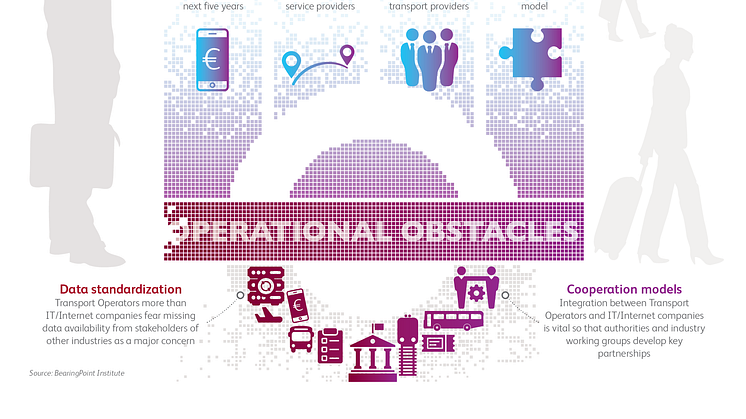
Pressmeddelande -
Multi-modal mobility platforms could transform public transportation as we know it
Stockholm, June 27, 2017 – It is a given that travelers – be they commuters, tourists, long distance or day-to-day customers – expect seamless, multi-modal journeys. But what do public transport operators believe? The BearingPoint Institute, the research arm of management and technology consultancy BearingPoint, surveyed 59 transport operators and other stakeholders from nine European countries as well as Japan and the US to get their perspective on intermodal mobility platforms. Whilst a clear majority recognized the inevitability of multi-modal end-to-end travel chains, the same proportion (85%) noted an array of challenges standing in the way.
The new BearingPoint Institute report explores these barriers, along with the opportunity scope involved in building a collaborative digital transport infrastructure. By doing so, the report sheds light on why digital intermodal mobility platforms do not yet exist, and in addition it provides recommendations on how to overcome existing hurdles.
Barriers to a transport ecosystem
Based on the survey results and in-depth interviews with eight industry leaders, three main challenges were examined. Firstly, business models are unclear and immature. When Return on Investment (ROI) is so uncertain, the impetus to commit resources to a full-scale mobility platform is eroded. In the absence of precedent, experts also concede the difficulty of understanding the consequences of a platform project.
Secondly, and compounding the business case, are technical and governance obstacles: data security, integration and management. A huge problem concerns how to underpin the physical transportation infrastructure with a digital infrastructure to solve service commissioning, payments and service validation. To date, the complexity and scale of these challenges has proved to be beyond the abilities of any single transport provider and authority. An example is the predicament of real-time data management.
Thirdly, there is a relationship obstacle: the lack of co-operation and support between stakeholders. Unsurprisingly, the usual competitive dynamics come into play. 55% of survey respondents agreed that intra-modal rivalry prevents traditional rail and public service providers from cooperating and competing against disruptive mobility stakeholders. However, since cooperative ventures form the backbone of a platform operation, these forces effectively put a brake on multi-modal mobility.
Even if not competing, each stakeholder group has reasons for being hesitant. For example, because transport operators are judged on the quality of their service, they are uneasy about bundling their services with external operators. Furthermore, they fiercely reject the idea of becoming downgraded to mere infrastructure or basic transport providers.
What should operators do?
The report focuses on overcoming collective action problems, arguing that the gap between transport stakeholders is the main bottleneck. Indeed, the opportunities unleashed by collaboration have not escaped the attention of industry leaders.
Based on the research, BearingPoint proposes a number of initiatives, including:
- Platform technology is available and already established in other industries. Thus, keep investing in platform business as customers are there.
- The good approach is not the usual engineer – build – operate model. Entering the platform business requires an agile test & learn model. There are two reasons for this: (1) rapidly gaining confirmation from the market for which services customer are ready to pay and (2) to progressively bridge the gap between the “old” transport engineers and the digital natives (millennials). This also means: be prepared for cultural change and take it seriously.
- The platform business model is based on traffic volumes and market dominance; there is an obvious “first mover advantage.” So, don’t wait too long as you may lose market share.
“From the research we can see that stakeholders need to get their act together if they want to take advantage of digital platforms to offer additional, more joined-up services. It’s up to authorities and operators to close the gap between what they are trying to achieve and the use of a digital platform, through closer collaboration and increased innovation,” comments Francois Lanquetot, Partner at BearingPoint.
For the full story, you can download the BearingPoint Institute report here: https://www.bearingpoint.com/en/our-success/thought-leadership/multi-modal-mobility/
Relaterade länkar
Ämnen
Kategorier
BearingPoint consultants understand that the world of business changes constantly and that the resulting complexities demand intelligent and adaptive solutions. Our clients, whether in commercial or financial industries or in government, experience real results when they work with us. We combine industry, operational and technology skills with relevant proprietary and other assets in order to tailor solutions for each client’s individual challenges. This adaptive approach is at the heart of our culture and has led to long-standing relationships with many of the world’s leading companies and organizations. Our global consulting network of 9,700 people serves clients in more than 70 countries and engages with them for measurable results and long-lasting success. For more information, please visit: www.bearingpoint.com



